It is nearly impossible to imagine the Mexican cuisine we know and love without Mexican cheese as a vital component. Enchiladas, chiles rellenos, chilaquiles, quesadillas and esquites….what would they be without cheese? Would these ubiquitous dishes even exist on the modern Mexican menus of today without the introduction of cheesemaking to Mexico?
While cheese seems inextricable to the cuisine of Mexico, it was introduced to the Mexican diet just a few hundred years ago when the Spanish brought over not only dairy-producing livestock but also their cheesemaking traditions to the New World. Today, there are upwards of 40 unique varieties of cheese produced in Mexico. But that was not always the case.
The History of Cheese in Mexico – The Prehispanic Diet
Contents
When the Spanish first settled in the Americas in the 1500s, cheese did not exist in the diet of the indigenous inhabitants. The introduction of cows, sheep and goats forever changed the landscape of Mexican cuisine which to this point did not include dairy and very little farmed meat.
The early inhabitants of Mexico were primarily hunters and gatherers. Their diet consisted mainly of grains such as teosinte (wild corn) amaranth, quinoa and chia, root vegetables such as sweet potatoes and cassava (yuca), fruit including mamey, mango and sapote, and of course the basis of the Mesoamerican diet, corn, beans and squash, the trio commonly referred to as The Three Sisters.
The cultivation of corn (maize) began thousands of years ago and has been an essential component in the mesoamerican diet from 7000 BC until the present day. Whether grilled in its husk and eaten fresh or dried and ground into masa, corn is inextricable from Mexican culture and cuisine.
Beans, the second sister in the trinity, are supported by the corn stalks and naturally return essential nitrogen to the soil. Beans were and still are a staple of the Mexican diet and when served with corn, make up an essential protein block for the Mexican diet. Flor de mayo, lima, wax, pinto, black and many other varieties of beans were cooked until soft in a large olla, flavored with epazote and chilies, and appeared at almost every meal.
The third sister, squash is known to have been cultivated even before corn. The significance of squash in the “milpa” is owned to its spreading ability which prevents the growth of weeds and helps retain moisture in the soil. Squash blossoms also attract bees and other important pollinators to the fields. Squash can be found cooked in soups and sweetened to make beverages and desserts. The flowers can also be eaten and gourds used as storage containers or as serving vessels.
Meat, as a protein source, would be a rare treat for the average person. Depending on the region, protein sources for the average mesoamerican might include, small deer, wild pigs and turkeys, armadillo, and iguana. Prehispanic inhabitants living near bodies of water might subsist on turtles, crocodiles and alligators (caiman) fish, lizards and snakes.
Insects also played a vital role in the mesoamerican diet. An excellent source of protein with levels ranging from 10 to 80 percent, the average inhabitant could easily fulfill their dietary needs by foraging for ants, crickets, grasshoppers and beetles as well as the eggs, pupae, and larvae of hundreds of regional insects.
The History of Cheese in Mexico – Post-Hispanic and Modern-Day Mexican Cuisine
Before the arrival of the Europeans in the New World, native societies of Mesoamerica relied mainly on hunting to provide themselves with meat and other animal products. The only known domesticated protein sources were turkeys, doves, ducks and dogs similar to Chihuahuas and the Mexican hairless Xoloitzcuintli. These were raised to be eaten primarily by the ruling classes and considered a delicacy like veal.
After the conquest of Mexico, the Spaniards introduced livestock such as cows, sheep and goats in great quantities which profoundly affected both the ecology, the indigenous populations and their diet.
Mexican markets, particularly in rural communities, vary little today from those described by the early Spanish settlers arriving to this newly discovered land just five hundred years ago.
You will still find piles of brightly colored fruits and vegetables, baskets brimming with chiles, fresh and dried, shiny dried beans, bundles of aromatic herbs and dried gourds filled with spices. There will still be vendors offering a plethora of dried insects and larvae.
However, wander through any Mexican market today and you will notice a few remarkable differences from prehispanic markets, not the least of which is the abundance of farmed meats meat, such as chicken, turkey, pork and beef, and dairy products including cheese.
Though introduced by conquering invaders, cheesemaking has evolved into an important regional occupation. In fact cheesemaking in Mexico has in now become a proud tradition, one generation passing down well-guarded family secrets and techniques to the next, producing cheeses entirely unique to Mexico.
Let’s take a closer look at the cheeses of modern Mexico.
Fresh Mexican Cheeses (Soft to Semi-Firm)
Like fresh American and European cheeses, Mexican fresh cheeses are mild in flavor, usually white or off-white in color. Some have a slight saltiness. Textures vary and range from moist and firm (queso manchego), to moist and grainy (requesón) to dry and crumbly (cotija).
When the making of these cheeses was being done only on a smaller scale, most had a shelf-life of fewer than seven days. Fresh cheese would be delivered to market wrapped in banana leaves. Any cheese left unsold after five days went back to the cheesemaker. With modern, larger-scale production, the fresh cheeses are still quite perishable and must be kept refrigerated, but most now have a longer shelf-life, especially because they are made in modern facilities from pasteurized milk and maintained in reliable refrigerated conditions.
Perhaps the biggest difference between fresh Mexico cheeses and fresh American-style cheeses is that the Mexican cheeses do not melt when they’re exposed to heat. They’ll become warm and softer in texture, but they do not lose shape and “break” or get runny.
Here are the most commonly-available fresh Mexican cheeses.
Queso Fresco

Queso Fresco (KAY-so FRES-KOH), is a soft, moist, fine-grained cheese traditionally made from a mixture of raw cows and goat’s milk. It is a mild, slightly salty cheese that crumbles readily, and is frequently used as a topping or filling in cooked dishes like enchiladas, refried beans, salads, soups, sopes and tostadas. It is a very simple cheese to make requiring few ingredients. As such it is made in many homes even today. This is a very popular cheese in Mexican homes and is starting to get a foothold in supermarkets in the United States and internationally. Queso Fresco made from pasteurized cow milk is now readily available to suit those markets and consumers.
Queso Blanco
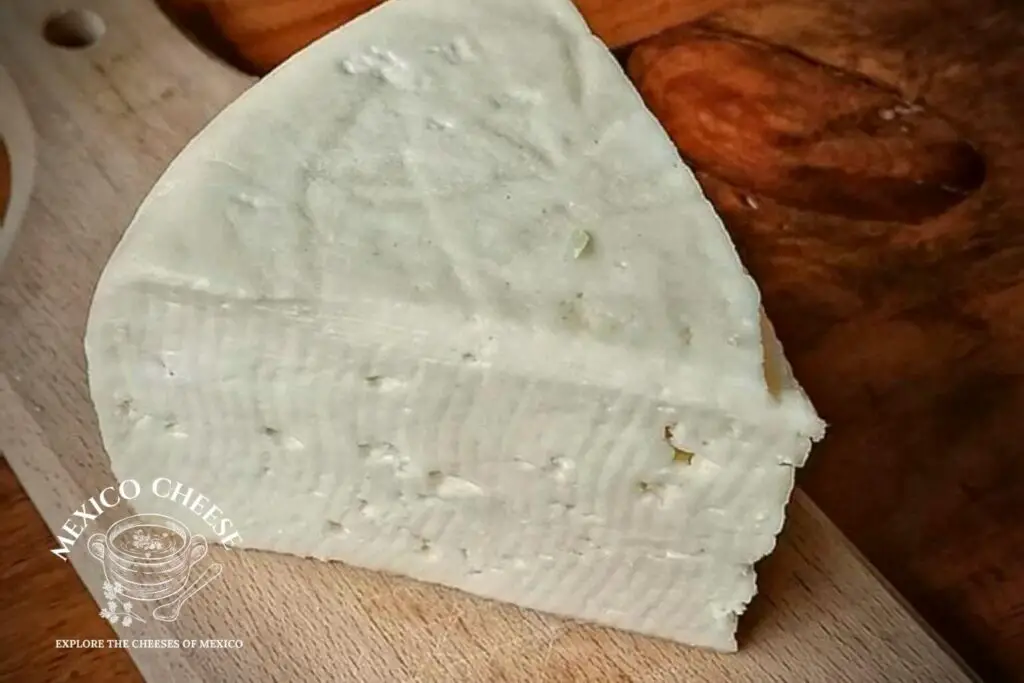
Queso Blanco (KAY-so BLAHN-koh) has a fresh, crumbly curdy texture and is traditionally made from 100% raw milk. A cooking and snacking cheese, it softens but holds its shape when heated. Queso blanco can be used interchangeably with queso fresco and may be consumed on its own as a snack but it is generally added to other dishes. It is often used melted atop dishes such as enchiladas and empanadas, or crumbled over soups or salads. The popularity of Queso Blanco has led to the need for a more shelf-stable product, made from pasteurized milk which is widely distributed in modern grocery stores.
Panela Cheese
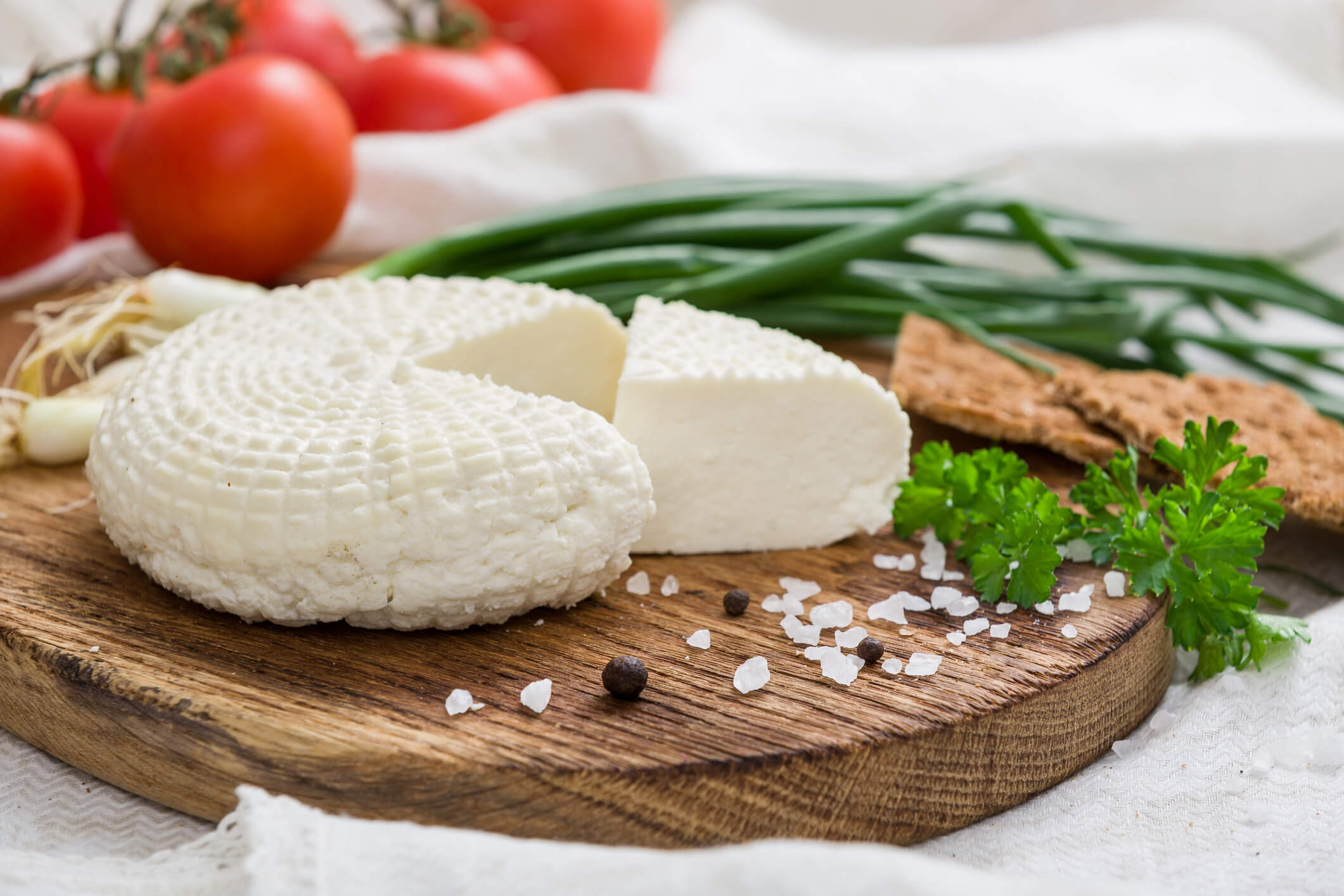
Queso Panela (KAY-so pah-NAY-lah), is similar in taste and texture to fresh mozzarella, but perhaps a bit firmer. Panela cheese has a lactic smell with aromas of whey. It has a subtle taste of fresh milk, sweet with notes of sour cream. Panela is low in salt. Its texture is fresh, chewy, moist and granular. It is often referred to as queso de canasta or “basket cheese” attributing to te It is commonly sliced for sandwiches or cubed for salads or on a cheese and fruit platter. If you have ever ordered a mocajete, this is the cheese most commonly included as it can be grilled and still maintain its shape. This semi-firm cheese can easily be used in place of Paneer or Haloumi. It is produced all over Mexico and can easily be found in the United States and internationally.
Tenate Cheese
Queso Tenate (KAY-so teh-NAH-tay) originated in Tlaxco in the State of Tlaxcala, and has been made there for over 100 years. Like Queso Blanco, Tenate cheese is a rindless, fresh cow’s milk cheese. During the rainy season when milk is plentiful it is produced and consumed fresh after just a few days of maturation. The rest is then kept to age (añejo) and enjoyed during the dry season. Tenate cheese is named for the container in which it is formed. Tenate is a cylindrical basket made of woven palm fronts. The baskets vary in diameter and height and as such, no wheel of cheese is exactly the same. The flavor is slightly salty and buttery and the aroma is slightly herbaceous due to the palm encasement. This is one of the artisanal cheeses unique to Mexico and is becoming increasingly difficult to find.
Adobera Cheese
Queso Adobera (KAY-so ah-doe-BEY-ra) originates from the west side of Mexico, and is named for the similarity of its shape to adobe bricks. Adobera cheese is produced by hand from 100% whole cow’s milk. This is a soft, fresh rindless cheese. It can often be found seasoned with a little chili or even marinades in adobo spices although traditionally the only seasoning is the salt used in the cheesemaking process. Adobera is a fresh, unripened cheese that does not go through the aging process. Adobera should be ivory-white color. Its flavor and aroma is fresh, with mild acidity and salinity. The texture is tender and granular, allowing for the cheese to crumble or melt depending on its use. The soft texture and its ability to melt easily make Adobera cheese a useful ingredient in a wide range of Mexican dishes such as quesadillas, and queso fundido. Queso Adobera is not commonly found in the United States or other parts of the world so you may have to make a special trip to Mexico to try it!
Requesón
Requesón (reh-kay-SOWN), is the Mexican equivalent of Ricotta. It is soft, creamy and mild. Requesón is made in a similar way to Ricotta where whey is mixed with residual curds and warmed. The curds are then skimmed off the top, strained and may be lightly pressed. Requesón is an ideal filling for enchiladas, chilis and any dish where you might use Ricotta. Seasoned with chiles and herbs it makes a nice spread for tapas. Try it spread on toast points, sprinkled with chopped nuts and drizzled with a bit of honey.
Crema Mexicana
Crema Mexicana (CREH-mah meh-hee-CAH-na), often referred to simply as crema, is technically NOT a cheese but no list would be complete without its inclusion. Mexican fresh cream is richer and more complex in flavor than American sour cream, more reminiscent of British clotted cream. You have undoubtedly seen Crema Mexicana used to finish many savory Mexican dishes, often then topped off with Cotija or Queso Fresco. However, it is also enjoyed over desserts, with breakfast cereal and with fresh berries.
Mexican Melting Cheese (Semi-Soft)
How do Mexican melting cheeses differ from fresh cheeses of Mexico? As the name implies, these cheeses are designed to melt when heated. Flavors and textures in these cheeses have a wider range than is seen in the fresh Mexican cheeses. Regardless of their region of origin, these cheeses are widely produced across Mexico and distributed nationally. They can all be found in the refrigerated sections of all major grocery chains across the country and many are finding a place in supermarkets in the United States and internationally.
Here are the most popular semi-soft, melting Mexican cheeses.
Manchego Cheese
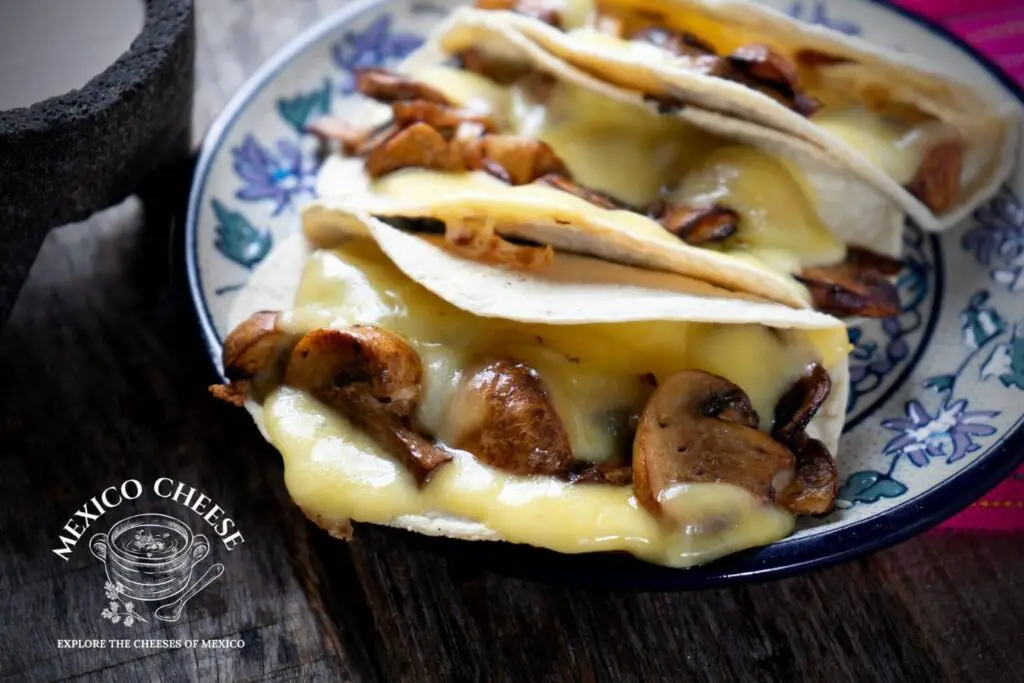
Queso Manchego (KAY-so mon-CHAY-go) is one of Spain’s most famous cheeses. While originally brought to the New World by Spanish settlers in the 1500s, the Manchego cheese commonly consumed in Mexico today bears little resemblance to its Spanish ancestor. In Spain, to be given the distinction “Manchego” the cheese must have been made from the milk of a particular kind of goat in a particular region of Spain. The cheesemaking process for Manchego has changed considerably since its introduction to the native Mesoamericans due in part to the availability of cow’s milk and the palate of the Mexican people. Modern Mexican Manchego is a rindless, firm-textured cheese with a buttery flavor and color to match. The taste is similar to a strong Monterrey Jack. Manchego is one of the most commonly used cheeses in Mexico and can be found in every grocery store, sliced, or in block form. Manchego is the perfect addition to a torta or a quesadilla or just enjoyed by itself as a snack with fruit and nuts. It can also be grated and melted over nachos, enchiladas or stuffed into a quesadilla.
Chihuahua Cheese
Queso Chihuahua (KAY-so chee-WAH-wah), also referred to as Queso Menonita and often just Queso Quesadilla, is mild in flavor, with the smooth, almost buttery texture of a young Gouda or a mild Cheddar. This cheese originated in a Mennonite community in Chihuahua and but it is widely produced all over Mexico. This cheese can be made with whole or skimmed milk, and it works well for slicing or shredding over salads, or shredded and melted over nachos, chili con carne and even pizza. It is a popular filling for quesadillas, chiles rellenos and enchiladas. It can also be cubed for a cheese platter. You can find versions made that may be studded with colorful peppers, epazote or jalapeño chiles but the cheese itself is not spicy.
Oaxaca Cheese
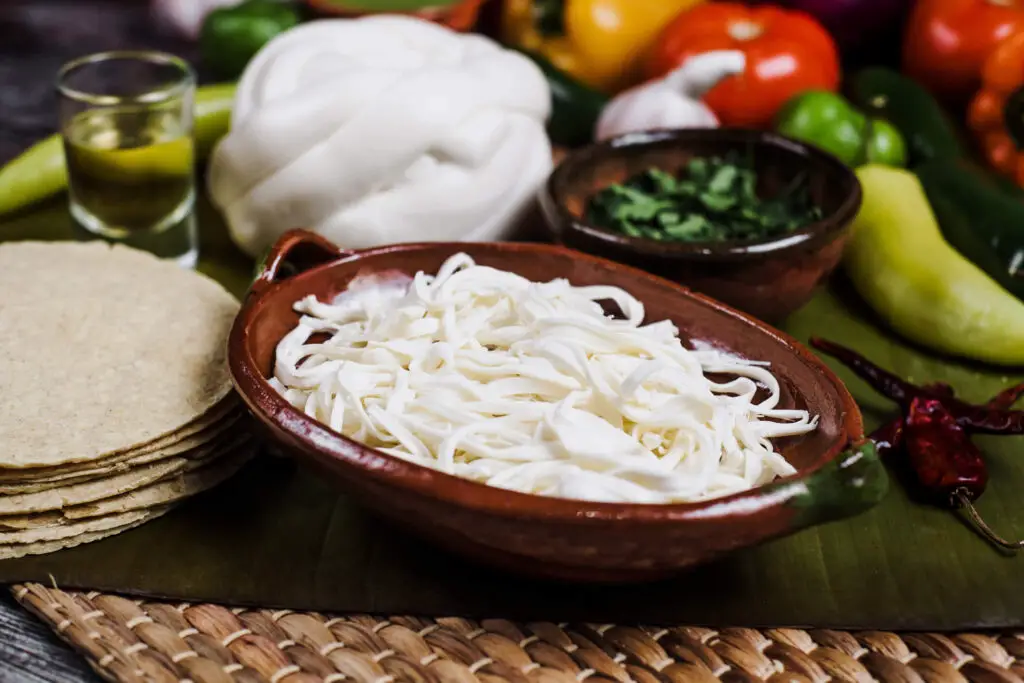
Queso Oaxaca (KAY-so wah-HA-kah) is known in its state of origin as simply Quesillo. It can most easily be described as a slightly salty mozzarella. The curds are heated to 80° Celcius, then stretched, exactly as is done when making mozzarella. Cheese “ropes” are formed from the stretched curd and carefully formed into ball-shaped knots for packaging. Queso Oaxaca is firm-textured and perfect for shredding, and it’s often shredded into dishes prior to cooking. American String Cheese is probably the best substitute for Queso Oaxaca if you are looking for that particular texture but you might also consider mozzarella cheese if you are looking for a similar flavor. Queso Oaxaca is great on its own as a snack but really shines when melted in a quesadilla or on top of a tlayuda. Like all artisanal cheeses, each Queso Oaxaca is slightly different. You will want to try them all!
Asadero Cheese
Queso Asadero (Kay-so ah-sah-DEH-roe) has a firm texture and is most often formed into a log shape, then sold in slices. Similar to Oaxaca cheese, it is made with a special kneading and stretching process however, Asadero cheese is generally less “stringy”. Asadero cheese is buttery and off-white in color. It is often sliced or shredded to use in quesadillas or other sandwiches. You may see versions embedded with jalapeño chiles. As the name Asadero implies, this is specifically a melting cheese, commonly used to make the Mexican fondue called queso fundido. Often served topped with sauteed mushrooms or crumpled chorizo, queso fundido is a very popular, late-night supper. This cheese is also delicious grated to melt over nachos. If you cannot find Queso Asadero in your local grocery, Fontina and Monterrey Jack are fine substitutes.
Criollo Cheese
Queso Criollo (KAY-so kree-OY-yoe) is a specialty of the region around Taxco, Guerrero. Queso Criollo is made from fresh, raw milk and is one of the few yellow cheeses in the country. The cheese is semi-firm. The flavors are mild and salty, but they become stronger as the cheese ages, when it will also become quite hard in texture. Criollo is typically grated over tortillas, quesadillas, or beans and rice. There are a few brands of Criollo Cheese that are manufactured for international distribution but they are quite different from what you will find in a Mexican market. The best substitute for Queso Criollo would be Muenster cheese which is so similar that the two can easily be used interchangeably. In Mexican grocery stores, substitutes for Criollo Cheese would be Mexican Manchego and Queso Chihuahua.
Mexican Aged Cheese (Semi-hard or Hard)
This final category of Mexican cheeses consists of aged or hard cheeses. As you might guess, these have a stronger flavor and a more crumbly texture than the fresh or melting cheeses. Within this category, there’s a subcategory of cheeses called “añejo,” meaning “old.” However, this does not refer to a long aging period. Instead, while these cheeses have been aged for some time, their dry texture and piquant, sharper taste result from the cheeses being salted, pressed, and dried. These cheeses used to be made by salting fresh cheeses and leaving them outdoors to age in the heat for up to a year. Fortunately, now we have production methods that are considered much safer and more reliable.
These are the aged, Mexican cheeses you need to know.
Cotija Cheese
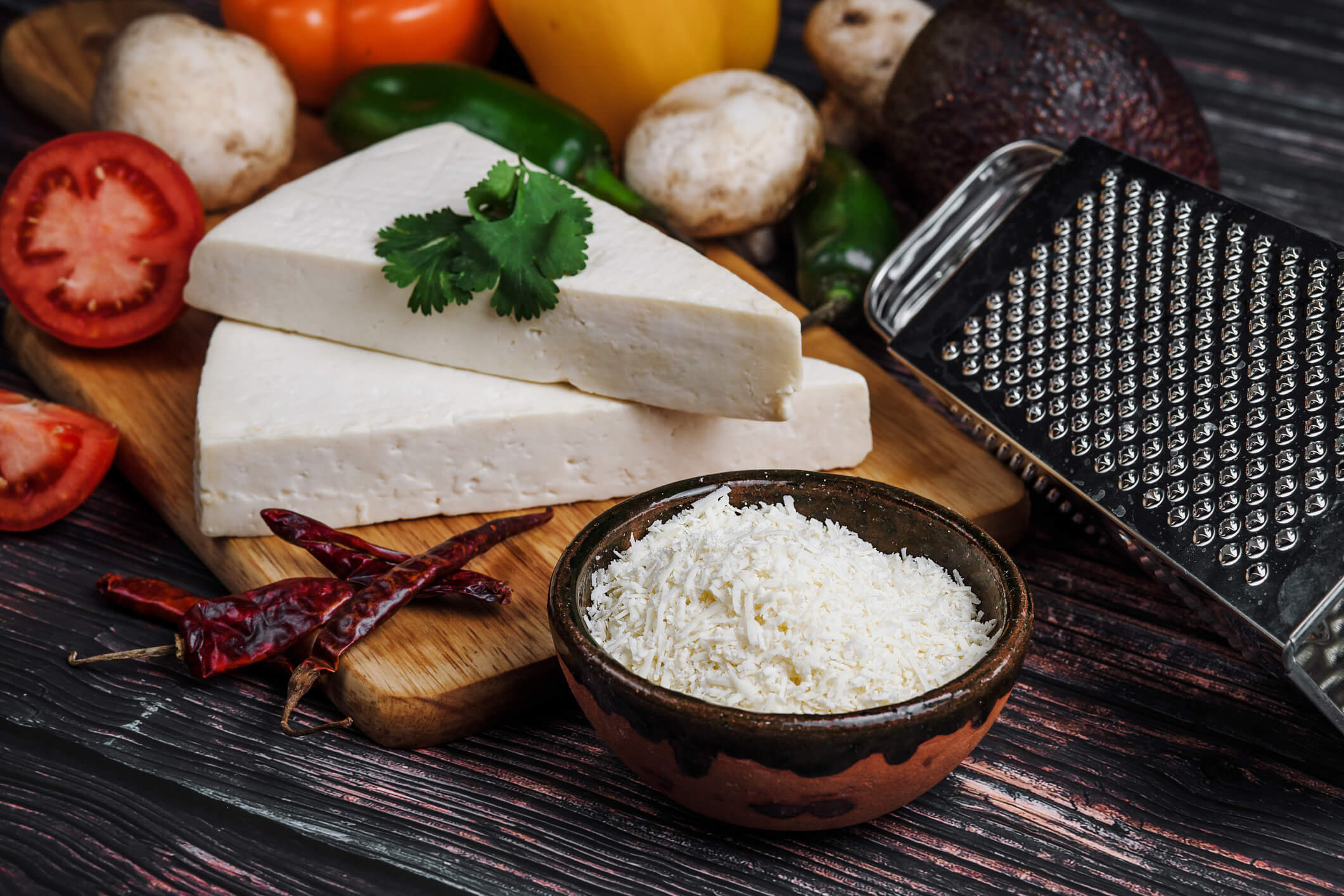
Queso Cotija (KAY-so coe-TEE-ha) is a very salty and pungent cheese, white in color and much like a dry version of Feta. Its texture can range from semi-firm to very firm, depending on the producer, but the cheese is always crumbly. Authentic cotija is prepared during the rainy season (May to September) with unpasteurized cow’s milk. The curds for this cheese are milled before being shaped and pressed back together and allowed to mature for anywhere from 3 months (fresh) to a year (añejo). What results is a salty, crumbly cheese commonly used as a savory seasoning to garnish soups, salads and bean dishes. A reasonable, less-salty substitute would be Queso Fresco. Try Cotija on top of fresh summer corn and black bean salad.
Cotija Añejo
Cotija Añejo (coe-TEE-ha on-YAY-hoe) is sometimes called Queso Añejo, “aged cheese,” or simply Añejo, “aged”. Cotija Añejo is a mainstay of Mexican dishes. Sometimes called “the Parmesan of Mexico,” it has a drier, harder texture, with a salty flavor, and will typically be grated over cooked foods or even shaved over salads. While traditionally made from fresh, raw cow’s milk, today, Cotija Añejo can be found made with pasteurized milk and is as popular in Mexico as parmesan is in Italy. Try grating it over grilled corn on the cob.
Cincho Cheese

Queso de Cincho (KAY-so day SEEN-choe) is a traditionally made cheese from the State of Guerrero. The name derives from the shape and texture created during the maturation of the cheese resulting in a wheel of cheese that appears to have been cinched by a belt. Queso Cincho is traditionally made from raw cow’s milk, rennet and salt, with no preservatives. The cheese has a distinctive salty flavor and herbaceous aroma. The texture is chunky and firm. Queso Cincho softens when heated, but it does not melt. This is not a Mexican cheese with wide production or distribution and may be difficult to find outside of traditional Mexican markets.
Enchilado Cheese
Queso Enchilado (KAY-so en-chee-LAH-doe) is sometimes labeled Queso de Cincho Enchilado and is one of the few Mexico cheeses that has a spicy element. This is essentially Queso de Cincho that has had a paste of spicy paprika or ground red chiles rubbed into its rind. This gives the cheese its distinctive reddish color and adds a slightly spicy tang to the flavor. Queso Enchilado is a firm, pressed cheese. While not as strong in flavor as Cotija, it does have a salty taste, a dry/hard/crumbly texture and is best grated or crumbled over soups and other cooked foods. Like many other Mexican cheeses, Queso Enchilado will soften when heated but will not run or lose its form.
Chontaleno
Queso Chontaleno (KAY-so shown-tah-LAY-noe) Chontaleo cheese is originally from Nicaragua but can be found extensively in Mexico and in Mexican cuisine. This is a salty, semi-hard cheese made from pasteurized cow’s milk. Chontaleno has a natural rind and is usually used as a table cheese. It is often used grated in baked dishes as you would use Parmesan or Romano cheeses. There is also a popular smoked version of this cheese, Chontaleño Ahumado.
Using Mexico Cheeses
Of the top ten fastest-growing specialty cheeses offered in retail outlets today, over half are from Mexico. As availability improves and expands, we anticipate that an increasing number of consumers will incorporate Mexican cheese into their cooking.
And don’t think you must stick to the same cheese within a category just because you’re familiar with it or it’s what is called for in a particular recipe. The majority of Mexican cheeses within a particular category are quite versatile and one can easily be used in place of another.
While aged Mexican cheeses tend to have distinct, sharper flavors but Chontaleno can easily be swapped out for Cotijo in your favorite recipes. Within the fresh cheese category, try substituting Queso Blanco for Queso Fresco. Need a wonderful melting cheese, try Queso Asadero in place of Queso Oaxaca. Any recipe that calls for Queso Criollo can easily be made with Mexican Manchego or Queso Chihuahua.
Substitutions will also depend upon what you can find locally, but as Mexican cheeses begin to filter into more international markets, that should become easier with time.
The next time you are in the supermarket, head over to the refrigerated cheese area and pick up one or two Mexican cheeses to try at home. Once you are a little more familiar with the cheeses of Mexico, you’ll discover at least one suitable for almost every type of dish and any occasion. Make it a point to try some (or all) of these Mexico cheeses soon. Their versatility and delicious taste will surely win you over.

4 thoughts on “The Ultimate Guide to Mexican Cheese”